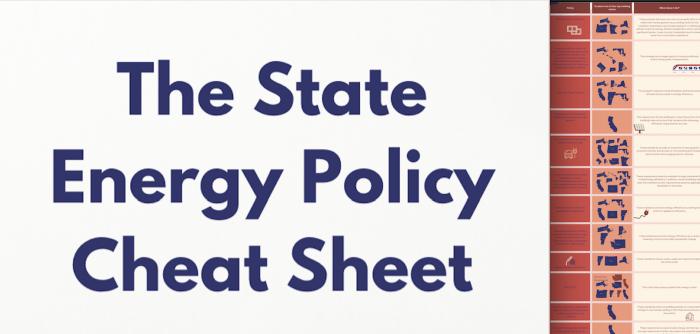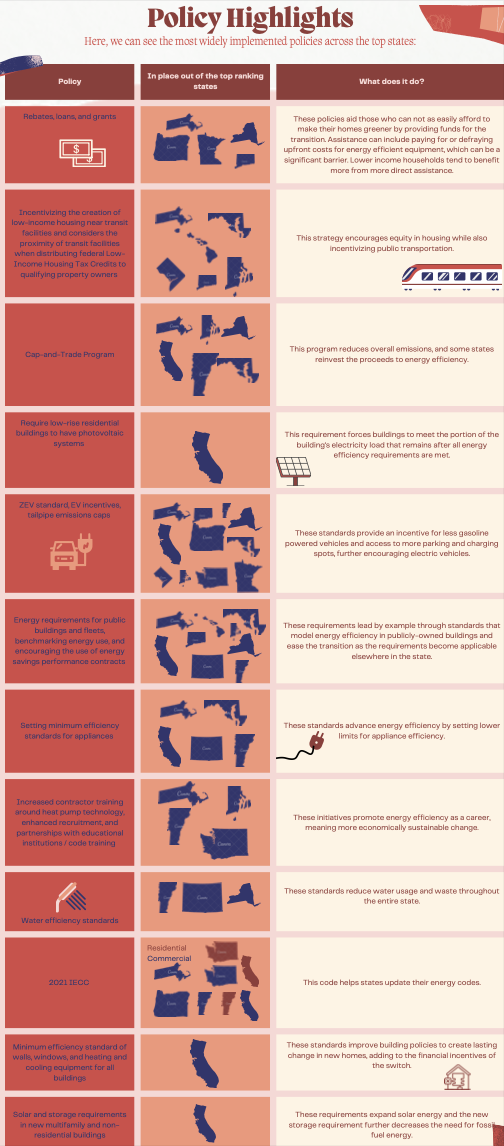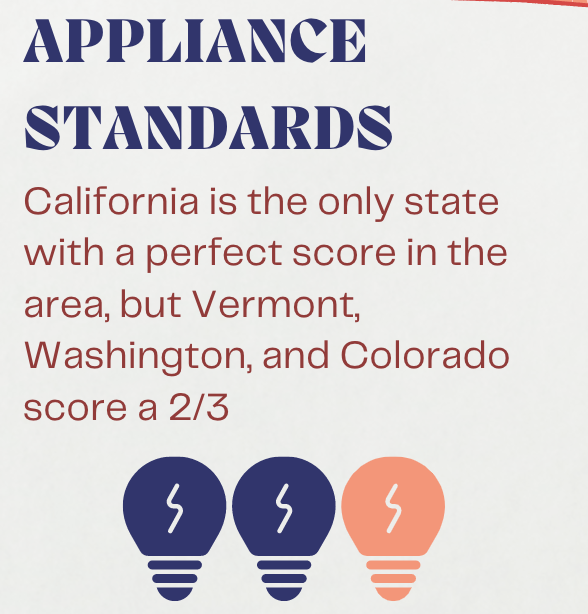The State Energy Policy Cheat Sheet: An Analysis of ACEEE’s Energy Efficiency Scorecard

A breakdown of state policies and actions advancing energy efficiency. Click to view the Energy Cheat Sheet Infographic.
ACEEE’s State Energy Efficiency Scorecard reports and provides analysis on energy efficiency-related policies and achievements in all 50 states and Washington, DC. In this infographic, we review leading states and key policies, as well as discuss the implications. It’s our goal to make this information accessible and approachable, as well as examine what this all means for states and for everyone, and to explore what we can expect, and do, to support improved energy efficiency policies and results.
Model State Energy Efficiency Policies by Category
On ACEEE's scorecard, states are ranked by their green and energy-efficient policies. Here we can see the highest scores by policy sector.
|
Utilities (maximum points: 20) |
MA -19.5 RI - 19.5 |
|
Transportation (maximum points: 12) |
CA - 10.5 NY - 10.5 MA - 10 |
|
Building policies (maximum points: 9) |
CA - 7.5 DC - 7.5 WA - 7.5 MA - 7 OR - 7 HI - 7 |
|
State-led initiatives (maximum points: 6) |
CA - 6 MA - 6 VT - 6 CT - 6 |
|
Appliance standards (maximum points: 3) |
CA - 3 VT - 2 WA - 2 CO - 2 |
Energy Efficency Policy Highlights
Here, we can see the most widely implemented policies across the top states:
What do these energy efficiency rankings mean?
We have all this information, but what is it saying? Well, first and foremost, these are the most energy efficient states in the US and their implementation of these policies grows as they approach the top of the list. This pattern means the more of these policies a state employs, the better their energy efficiency. Better energy efficiency means decreased energy use, meaning lower carbon emissions from the state, helping to mitigate climate change impacts.
These cited states are all at the top of the list in the US for energy efficiency, but some of them are still missing important initiatives, meaning all states have places to improve to reduce the nation's energy waste, further exemplified by the fact that no state has a perfect energy efficiency score. Furthermore, some states have perfect scores in certain categories while lacking in others. Using these gaps, more targeted guidelines can be composed based on categorical scores instead of overall state score, helping all states, even those with the highest energy efficiency scores, improve their energy policies. If a state isn't mentioned in the data, the state's government is using little to none of the policy initiatives among the more energy-efficient states. This chart acts as a map to energy-efficient policy in states where legislators haven’t employed these strategies, and how to analyze where a state's energy efficiency actually comes from.
What is missing in the less energy efficient states?
Overall, as we move further down the rankings which track progress, common policies missing seem to be:
- Financial incentives - a strategy which provides better access to these opportunities
- Energy requirements for public buildings and fleets
- Benchmarking energy use
- Encouraging the use of energy savings performance contracts
- Incentivizing the construction of low-income housing near transit facilities and rewarding this proximity when distributing federal Low-Income Housing Tax Credits
- 2021 IECC - an energy code updated every few years and while more states employ earlier versions, refusing to update reduces energy savings, explaining lower green building efficacy scores
As we move further down the list of rankings we see most, if not all, of these missing.
What specifically makes some energy efficiency policies more inclusive than others?
Rebates, grant, and loans, along with creating incentives for low-income housing near transportation facilities and considering the proximity to this transit when allocating federal Low-Income Housing Tax Credits to property owners, help low-to-moderate income (LMI) households and those of which often tend to be POC, creating more racial and economic equity.
Are energy efficiency policies linked to health?
The short answer is yes. While health may not be completely, directly attributed to energy efficiency as many factors affect health, out of the top 15 states with the lowest mortality rate in the country, 10 states appear in the top 15 of the states with the best energy efficiency. This health correlation is not surprising, given that policies that support more energy efficiency also tend to promote and advance healthier indoor air quality and comfort. Additionally, lower fossil fuel consumption also means less pollution and better outdoor air quality, in specific areas and of course for the wider environment. Globally, outdoor air pollution is attributed to 3 million premature deaths annually. Though perhaps harder to quantify overall and accurately, energy poverty, as defined by households spending more than 10% of income on energy, is also often combined with suboptimal housing quality and both mental and physical health. Studies do clearly show that fossil fuel consumption is correlated with higher health risks, particularly in vulnerable populations.
No state even hits an 8/9 in the building policies sector, so how would a state even approach gaining a perfect score?
Better design and building practices can also help address indoor environmental quality challenges. These strategies include:
- Daylighting – the strategic placement of windows to optimize sunlight for indoor lighting, reducing the need for energy use
- Increased natural air ventilation – the improvement of air quality through increasing natural air throughout the building
- Moisture reduction – the reduction of humidity and moisture to improve air quality and decrease the risk of mold
- Low-emitting floor carpets, glues, paints – the aversion materials which emit indoor air pollutants, such as VOCs, and using healthier ones instead, improving indoor air quality
- Targets for:
- water use
- wastewater generation
- land conversion
- use of green materials
- embodied energy
- waste loads
States should also emphasize the appropriate use of mandates, in addition to incentives to further the target of a green building standard. State and city governments should also work towards the integration of educational programs related to green building with comprehensive urban development programs for the sake of creating more green and sustainable communities.
An example of problems in even the most successful states is in Massachusetts' new stretch code, a more aggressive code than a base code which provides higher energy savings, alleviating market acceptance to energy codes. However, although stretch codes are beneficial to energy efficiency, environmentalists take issue with this new code because it is not as aggressive as one might hope, still allowing for fossil fuel usage, although requiring solar panels and wiring for eventual electrification. Aggressive policies are difficult to pass even in the most progressive states, which is where citizens can utilize their own power to put pressure on their governments.
Even the highest-ranking states in utilities aren’t perfect, why and what can be done?
State governments should seek renewable portfolio standards, meaning that a portion of a state’s energy must be renewable, with tax benefits and clean energy fund grants for the development of large-scale green utility implementation, the interconnection of renewable resources and the transmission of them, performance rate reforms for energy usage or other incentives for the use of renewables and less energy usage overall, and additionally integrated resource planning for sustainable energy usage. On the federal level, a useful strategy could be the implementation of feed-in / green tariffs, allowing consumers to source the entirety of their energy from renewables and providing renewable energy producers a higher rate than the market price.
Appliance standards in almost every state are basically non-existent, why and what’s to be done?
Appliance standards, in the form of efficiency level requirements of a product to reduce energy waste, have not been implemented in many states, with only California receiving a perfect score. The problem with appliance standards is that these environmental benefits are typically quite small compared to the high costs of the standards, and the DOE tends to miscalculate the actual cost these appliances will have on an average consumer, a problem with the upfront cost without the grants or rebates to help people cover them. Also, states are barred from establishing state energy-efficiency standards for products already covered by federal standards; however, state efficiency standards are a better solution because as technology develops, state legislation can be better suited to push forward responding laws more quickly.
What would a perfect set of transportation policies look like if no state has achieved it?

Integrated transportation and land use planning provide opportunities for more sustainable transportation, also creating more choices and helping improve air quality and reduce greenhouse gas emissions. (For a helpful summary of these policies, see this summary UN presentation). Additionally, a useful strategy is smart and sustainable street design by looking at more sustainable materials than carbon-producing concrete, developing communities in a way that favors more sustainable transportation, such as access to public transit, and parking management which encourages walking and use of public transportation, but also reduces development and infill costs. Digital technologies are also an important tool as we develop different forms of transport infrastructure for greater sustainability with data monitoring road conditions, predicting needs for maintenance by looking at those roads with excessive usage and preventing lane closures and blockages to reduce traffic and the resulting emissions from idling cars.
Why should the average person care about energy efficiency policies?
Without strong energy efficiency policies, people lose access to electricity savings, using more energy efficient utilities. More access to renewable and energy efficient opportunities also means less air pollution due to less fossil fuel production. This reduction results in lower healthcare costs, also due to lack of symptoms of sick building syndrome. Moreover, as gas prices rapidly increase, electric appliance savings rapidly increase with them. These savings and health benefits further ease the financial burden on those in poverty or LMI households. Furthermore, with greener and more accessible transportation, people save on fuel and vehicles, also reducing air pollution, the increased demand for green vehicle and battery manufacturing, along with fuel production, creates more jobs, and we rely less on foreign materials and fuels, meaning more sustainable energy independence.
What can everyone do to improve their state’s overall efficiency?
We can all learn more about our state’s policies and opportunities on energy efficiency and clean energy and hold legislators accountable for making statewide change. Writing to state legislators and voting in those who support beneficial energy efficiency policies is essential to creating statewide change. On an even more individual level, switching to efficient utilities and appliances helps the environment and is financially beneficial in savings. Here’s some further reading on energy advocacy, to help us all understand what we can be doing to progress energy efficiency in the US: https://environmentamerica.org/blogs/environment-america-blog/ame/what-kind-renewable-energy-advocate-are-you
State Energy Efficiency Policy References:
ACEEE. (2020). The State Energy Efficiency Scorecard. https://www.aceee.org/state-policy/scorecard
ACEEE. (2021). Equitable Access to Transportation | ACEEE. https://database.aceee.org/state/equitable-access-transportation
Booth, A., Brown, G., de Sá, S., Houghton, B., Polymeneas, E., Raspino, B., Tai, H., & Wagner, A. (2022, March 3). Decarbonizing US gas utilities: The potential role of a clean-fuels system in the energy transition. McKinsey & Company. https://www.mckinsey.com/industries/electric-power-and-natural-gas/our-insights/decarbonizing-us-gas-utilities-the-potential-role-of-a-clean-fuels-system-in-the-energy-transition
Commonwealth of Massachusetts. (2021, March 26). Governor Baker Signs Climate Legislation to Reduce Greenhouse Gas Emissions, Protect Environmental Justice Communities. Mass.Gov. https://www.mass.gov/news/governor-baker-signs-climate-legislation-to-reduce-greenhouse-gas-emissions-protect-environmental-justice-communities
Commonwealth of Massachusetts. (2022a). Building Energy Code. Mass.Gov. https://www.mass.gov/info-details/building-energy-code#stretch-code-summary-
Commonwealth of Massachusetts. (2022b). LBE Priorities and Efforts: High-Performance Efficient Buildings. Mass.Gov. https://www.mass.gov/info-details/lbe-priorities-and-efforts-high-performance-efficient-buildings
Dudley, S. E. (2019, March 7). Appliance Standards Are Expensive, And Regressive Too. Forbes. https://www.forbes.com/sites/susandudley/2019/03/07/appliance-standards-are-expensive-and-regressive-too/?sh=3f0a1e61b41d
Energy Innovation: Policy and Technology, & O’Boyle, M. (2022, January 27). Three Ways Utilities Can Keep Pace With The Unprecedented Amounts Of Clean Power Coming Online. Forbes. https://www.forbes.com/sites/energyinnovation/2022/01/26/three-ways-utilities-can-keep-pace-with-the-unprecedented-amounts-of-clean-power-coming-online/?sh=41345f6674ed
EPA. (2021, November 5). State Renewable Energy Resources. US EPA. https://www.epa.gov/statelocalenergy/state-renewable-energy-resources
EPA. (2022, April 21). Smart Growth and Transportation. US EPA. https://www.epa.gov/smartgrowth/smart-growth-and-transportation
Kresowik, M., & Roselund, C. (2022, March 2). Federal Efficiency Standards: A Win for Families, Health & Climate. RMI. https://rmi.org/federal-efficiency-standards-a-win-for-families-health-climate/
Lovett, A. L. A. (2022, March 9). State updating building code to include net-zero option. Massachusetts Municipal Association (MMA). https://www.mma.org/state-updating-building-code-to-include-net-zero-option/
MCAN. (n.d.). Net Zero Building Codes. Massachusetts Climate Action Network. https://www.massclimateaction.org/net_zero_building_codes
Milani, L., Mohr, D., & Sandri, N. (2022, April 12). Built to last: Making sustainability a priority in transport infrastructure. McKinsey & Company. https://www.mckinsey.com/industries/travel-logistics-and-infrastructure/our-insights/built-to-last-making-sustainability-a-priority-in-transport-infrastructure
NEEP. (2022). Federal and State Appliance Efficiency Standards. Northeast Energy Efficiency Partnerships. https://neep.org/smart-efficient-low-carbon-building-energy-solutions/appliance-efficiency-standards
Office of Energy Efficiency & Renewable Energy. (n.d.). Sustainable Transportation. US Department of Energy. https://www.energy.gov/eere/sustainable-transportation
Office of Energy Efficiency and Renewable Energy. (n.d.). About the Appliance and Equipment Standards Program. US Department of Energy. https://www.energy.gov/eere/buildings/about-appliance-and-equipment-standards-program
State and Local Solution Center. (n.d.). Renewable Energy: Utility-Scale Policies and Programs. Energy.Gov. https://www.energy.gov/eere/slsc/renewable-energy-utility-scale-policies-and-programs
Tawney, L., & Ryor, J. (2014). How Green Tariffs Can Benefit Utilities and Consumers. World Resources Institute. https://www.wri.org/insights/how-green-tariffs-can-benefit-utilities-and-consumers
Urbanek, L. (2019). State Efficiency Standards Are Good For Everyone. NRDC. https://www.nrdc.org/experts/lauren-urbanek/more-states-ever-are-pursuing-state-standards
U.S. Department of Energy. (2022). Status of State Energy Code Adoption | Building Energy Codes Program. https://www.energycodes.gov/status
Wasser, M. (2022, March 17). Mass. is drafting a new climate-friendly building code. Here’s what you need to know | WBUR News. WBUR.Org. https://www.wbur.org/news/2022/03/17/massachusetts-energy-environmental-building-code-proposal-explainer
- Filed Under: Government Policies
- Keywords : Energy Efficiency, Sustainable Transportation, Building Codes, Green Building Policy, Energy Efficiency Incentives and Rebates, Environmental Policy, State Policy, Building Green, Green Building Policies
- ( 3596 ) views
- ( 0 ) Ratings
- ( 5 ) Discussions
- ( 0 ) Group Posts
Reply/Leave a Comment (You must be logged in to leave a comment)
The biggest challenge and frustration is when policy prevents you from building better. There are HOA's that prevent solar. As a builder, my insurance company did not want me to have renewable energy listed as a service, or they would drop me.
Individuals who want to do the right thing have to "go uphill both ways," which is unfortunate.
Education at all levels is the key for us to make progress. Unfortunately, policy alone will not fix mistakes from the past or current bad designs.
If you don't live in a state with mandates, you can still build an environmentally friendly, high-performance building. It will be up to individuals and better policy working together to solve some of these problems.
Regarding appliances, most states and manufacturers just fall in line with CA. It is too expensive to have 50 different car and appliance regulations, so everyone lets CA set the standard because they are the largest.
Connect with us!
Subscribe to our monthly newsletter:
 Greenbuild Report Out, 2025 Nov 12, 2025
Greenbuild Report Out, 2025 Nov 12, 2025











.png)























Not a Member Yet? Register and Join the Community | Log in